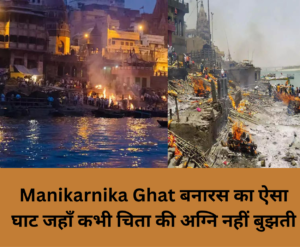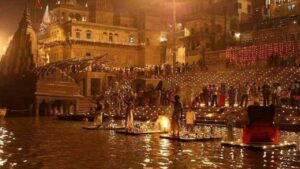My Ghat walk from Assi to Namo Ghat in Varanasi. Varanasi, also known as Benares or Kashi, is one of the oldest continuously inhabited cities in the world. It is a spiritual and cultural hub of India, and attracts visitors from all over the world. One of the most popular activities for tourists in Varanasi is taking a ghat walk along the banks of the Ganges river. In this blog, I will take you on a journey of my own Varanasi ghat walk and share my experiences.
Ghats are a series of steps leading down to the river, where people can perform religious rituals, take a dip in the holy waters, and even cremate their loved ones. There are over 80 ghats in Varanasi, each with its own unique history and significance. The ghat walk is an opportunity to experience the culture and traditions of Varanasi firsthand, and to witness the daily activities of the locals.
I started my ghat walk early in the morning, just before sunrise. The air was still cool, and the sky was just starting to turn pink. The first ghat I visited was Assi Ghat, which is is the southernmost ghat in Varanasi and is known for its peaceful and serene atmosphere. It is believed that Lord Shiva bathed here after slaying the demon Durgam. The ghat is also known for its long flight of steps, which are illuminated by lamps during the evening aarti (ceremony), creating a magical ambiance. The ghat is also famous for the Kashi Vishwanath Temple, which is located nearby.This ghat is known for its lively atmosphere and colorful boats, which take visitors on rides along the river. There were already a few locals and tourists gathered at the ghat, some performing puja (worship) and others taking a dip in the river.
And very next ghat from Assi Ghat is Tulsi Ghat is dedicated to the famous poet, Tulsi Das, who wrote the Ramcharitmanas. This is one of the Famous Ghat in Varanasi .
Moving on from the Assi Ghat there were may beautiful ghats in between with beautiful paintings and public taking dip in holy river ganga many of them enjoying boating and then we came to the Harishchandra Ghat, which is another important ghat in Varanasi. It is named after the mythological king Harishchandra, who is said to have worked here as a cremator. The ghat is used for cremations of people who cannot afford the expensive wood used for funeral pyres at the Manikarnika Ghat. The ghat is always busy with the sounds of crying relatives and the smell of burning wood, but it is also a reminder of the importance of compassion and helping those in need.
As the day progressed, the crowds at the ghats grew larger and more chaotic. There were boat rides, street performances, and even a cricket game taking place on one of the ghats. I saw families gathering to celebrate weddings and other important events, and I also saw some somber funerals taking place. Despite the constant activity, there was a sense of calm and acceptance in the air.
The ghat walk is also an opportunity to indulge in the local cuisine of Varanasi. We found many street food some of them selling chaats, maggie, Tea, Golgappe which are famous cuisine of Varanasi.
As I walked along the ghats, I couldn’t help but notice the beautiful architecture and intricate carvings on the buildings. Many of the ghats were built during the 18th and 19th centuries by wealthy merchants and nobles, and they are a testament to the city’s rich cultural heritage. One of the most impressive ghats I saw was the Manikarnika Ghat, which is the main cremation ghat in Varanasi. The ghat was bustling with activity, as families prepared to bid farewell to their loved ones.
Then we came to dasaswamedh Ghat which is the hub of cultural and religious activities in Varanasi. The ghat is lined with a row of temples and is known for its famous evening aarti ceremony. The aarti is a ritual where priests offer prayers to the river Ganga, using fire lamps and flowers. The aarti is a sight to behold and attracts a large number of tourists and locals alike. The walk can be timed to coincide with the aarti, to experience the beauty of the ceremony.
Read more about Dashaswamedh Ghat Click Here
Manikarnika Ghat which is next to Dashaswamedh Ghat , Manikarnika Ghat in Varanasi, also known as Manikarnika Burning Ghat, is one of the oldest and most sacred ghats in the holy city of Varanasi, India. It is believed that this ghat is the place where Goddess Parvati dropped her earrings (Manikarnika) while bathing in the holy waters of the Ganges. The ghat is famous for its cremation ceremonies, where Hindus come to perform the last rites of their loved ones and attain moksha, or liberation from the cycle of birth and death. The history of Manikarnika Ghat in Varanasi dates back to ancient times. According to Hindu mythology, the ghat is considered to be one of the holiest places in India, as it is believed to be the place where Lord Shiva and Goddess Parvati themselves come to bathe in the holy waters of the Ganges.
As I continued my walk, I encountered many sadhus (holy men) and pandits (priests) who were offering blessings and performing rituals for the locals. They wore brightly colored robes and had long beards, and they exuded an aura of peace and serenity. I also saw many vendors selling flowers, sweets, and other offerings for puja. It was a chaotic and colorful scene, but it all seemed to flow seamlessly together.
You will find many Accomodation on the Ghats with different price ranges opposite side of ghats we saw a beautiful tent city which consist of Luxurious Tents with all the Luxurious facilities.Find out the price of tent city and images on booking.com
After Manikarnika Ghat we saw many beautiful ghats less crowded it is because many of the tourists take a walk from Assi to Dashaswamedh so after dashaswamedh till the ghat which very close to namo ghat we did not find much crowd but one should take a walk from dashaswamedh to namo ghat because we found many beautiful ghats in between.
Last ghat was Namo ghat which is one of the beautiful ghat of Varanasi with so much crowd.The name “Namo is derived from Lord Shiva. It is very neat and clean ghat with children playing all over the ghats with toy trains and other things. We saw beautiful view of river ganga and one of the most amazing thing was we saw three modes of transportaton on Rajghat pul. Train, Road and Boat.We saw all the three modes of transportaion at the same which was very beautiful see this on my instagram reel. Click here to see the reel
So One of the highlights of my ghat walk was watching the sunrise over the Ganges. The sky turned a brilliant orange and red, and the river began to shimmer in the light. It was a breathtaking moment, and it made me appreciate the beauty and power of nature. I also saw many locals performing their morning rituals, including yoga and meditation. It was a reminder that Varanasi is not just a tourist destination, but a living, breathing city with a rich spiritual tradition.All I can say it was the best walk tour of my life seeing different peoples from around the world , seeing monks performing ritual activities,newly married couple performing their rituals, boats, river ganga, beautiful ghats and so many things which i cant describe in my own words.One who is visiting to varanasi should take a ghat walk you will find different taste of Varanasi.




